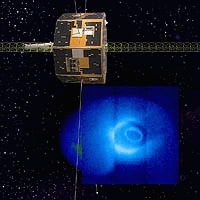IMAGE
Simulation Movie
Simulation Movie


IMAGE simulation movie in Quicktime ( 37M) or in MPEG (9.3M)
| IMAGE Orbit | Radio Plasma Imager (RPI) | Dst | |||
 |
 |
 |
|||
| QuickTime | MPEG | QuickTime | MPEG | ||
| IMAGE instrument data products are modeled, based on the anticipated IMAGE spacecraft orbit, instrument characteristics, and for magnetospheric conditions believed to have occurred during the October 18th and 19th solar magnetic cloud event. Apogee is placed near 15 hours MLT and 60 degrees magnetic latitude. | Radio echo strength is simulated first for inward looking plasmaspheric echos, at intermediate altitudes, and then for outward looking magnetopause echos when the IMAGE spacecraft is near apogee. Of particular importance will be the RPI capability to image large scale irregularities across the magnetopause, as shown with the simulated Kelvin-Helmholtz waves that can be seen propagating along its surface. | This storm-time, ring current index is shown for the purpose of orienting the observer to the variations in storm conditions during the simulation. | |||
| Extreme Ultraviolet (EUV) | Far Ultraviolet (FUV/SI) | Far Ultraviolet (FUV/WIC) | |||
 |
 |
 |
|||
| QuickTime | MPEG | QuickTime | MPEG | QuickTime | MPEG |
| Modeled cold plasma He+ densities are viewed in a time series simulation of EUV imager data products. Poisson and dark counting noise has been added, along with variation in the relative integration time across the conic instrument aperture. The appearance of the earth's shadow in EUV images provides an immediate orientation for the observer. Erosion of the plasmasphere with the formation of a sunward extended tail is evident in the images at the peak of the storm. The recapture and corotation of the sunward extended tail is visible during storm recovery, late in the simulation. | The FUV imager simulations presented in the video show realistic calculations of OI 135.6 nm and HI 121.6 nm emissions over the Earth. Auroral activity was simulated using the Hardy statistical models for both protons and electrons. Brightnesses for the OI 135.6 nm and HI 121.6 nm features were estimated using yield curves, and appropriate dayglow emissions were also added to the images. Using the expected sensitivity of the FUV imager detectors, the calculated brightnesses were then converted to counts, and appropriate dark and counting noise were added. | ||||
| Low Energy Neutral Atoms (LENA) | Medium Energy Neutral Atoms (MENA) | High Energy Neutral Atoms (HENA) | |||
 |
 |
 |
|||
| QuickTime | MPEG | QuickTime | MPEG | QuickTime | MPEG |
| During the first day of the event the magnetic activity climbs from a Kp near 2 to a Kp of 7. This causes an factor of about 12 increase in the overall outflux of O+ from the ionosphere. This can be seen in the increase in the overall intensity of the O+ images over this time. When the spacecraft is not too far away from the magnetic equator both northern and southern auroral zone upflows can be seen. This sequence of images is for the high energy end of the LENA instrument (128-300 eV). They are brighter than what is seen in the low energy (10-23 eV) range because of the degree of ion energization assumed to ocurr at low altitude in the model. If the ions were not so energized at low altitude then the low energy images would be brighter. | These are neutral atom images of the ring current seen by MENA and HENA. Strong fluxes are seen near the storm maximum (at minimum Dst) as a result of strong convection and the enhanced ion fluxes at the injection boundary. | ||||